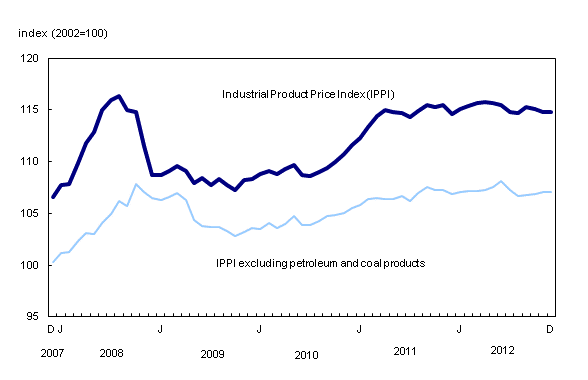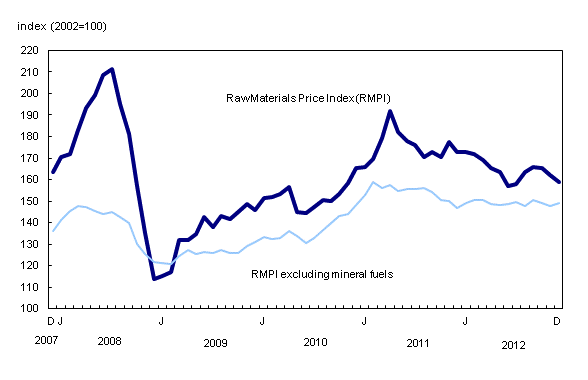The Daily — Industrial product and raw materials price indexes, December 2012
Archived Content
Information identified as archived is provided for reference, research or recordkeeping purposes. It is not subject to the Government of Canada Web Standards and has not been altered or updated since it was archived. Please "contact us" to request a format other than those available.
Related subjects
-
[an error occurred while processing this directive]
In December, the Industrial Product Price Index (IPPI) was unchanged compared with November. An increase in primary metal products (+0.9%) was offset mainly by a decline in motor vehicles and other transportation equipment (-0.5%). The Raw Materials Price Index (RMPI) fell 2.0%, largely because of lower prices for crude oil.
Prices for industrial goods are unchanged

Chart description: Prices for industrial goods are unchanged
Industrial Product Price Index, monthly change
The IPPI was unchanged in December following two consecutive declines. Of the 21 major commodity groups, 6 were up, 11 were down, and 4 were unchanged.
Primary metal products (+0.9%) posted the largest gain, resulting from price increases for aluminum products (+2.6%), copper and copper alloy products (+3.1%) and nickel products (+6.0%). The advance in metals was partly due to signs of increased economic activity in China.
Other commodities that posted increases included lumber and other wood products (+1.0%), pushed upward by higher prices for lumber and ties (+2.0%).
The largest price decline was in motor vehicles and other transportation equipment (-0.5%), which offset most of the increases observed in the IPPI. The decline was largely because of the appreciation of the Canadian dollar relative to the US dollar.
Some Canadian producers who export their products report their prices in US dollars. Consequently, the 0.7% rise in the Canadian dollar against the US dollar in December could have the effect of reducing the corresponding prices in Canadian dollars. Without the measurable effect of the exchange rate, the IPPI would have increased 0.2% instead of remaining unchanged.
Petroleum and coal products (-0.5%) moved downward in December, primarily because of lower prices for gasoline (-1.5%).
Industrial Product Price Index, 12-month change
Compared with December 2011, the IPPI was up 0.2%, the first year-over-year increase in five months.
Upward pressure was exerted on the index mainly by an increase in lumber and other wood products (+8.7%), largely because of higher prices for lumber and ties (+13.1%). On a year-over-year basis, prices for lumber and other wood products have increased every month since February 2012.
Among the other products that contributed to the IPPI increase were meat, fish and dairy products (+1.1%), petroleum and coal products (+0.4%) as well as rubber, leather and plastic fabricated products (+1.2%).
Conversely, the year-over-year increase of the index was moderated by motor vehicles and other transportation equipment (-1.6%). The decline was primarily a result of the appreciation of the Canadian dollar against the US dollar compared with December 2011.
The 3.5% year-over-year increase in the value of the Canadian dollar relative to the US dollar may have the effect of lowering the IPPI. Without the measurable effect of the exchange rate, the index would have risen 1.0% instead of 0.2%.
The advance of the IPPI was also partly moderated by pulp and paper products, fabricated metal products and chemical products.
Raw Materials Price Index, monthly change
The RMPI was down 2.0% in December, the third consecutive decline.
Prices for raw materials decrease

Chart description: Prices for raw materials decrease
The decrease of the index was almost entirely attributable to lower prices for mineral fuels, specifically crude oil (-5.9%). The RMPI excluding mineral fuels rose 0.9% in December.
Among the other product groups that declined was vegetable products (-0.9%), resulting from lower prices for grain, particularly corn and wheat.
The downward movement of the RMPI was partly moderated by non-ferrous metals (+2.7%), mainly because of higher prices for copper concentrates (+4.2%).
Animals and animal products and ferrous materials also slowed the decline of the RMPI.
Raw Materials Price Index, 12-month change
Compared with December 2011, the RMPI was down 8.0%. On a year-over-year basis, the index has not recorded an increase since February 2012.
The decline of the RMPI was largely because of mineral fuels, specifically crude oil (-18.3%). The RMPI excluding mineral fuels rose 1.4% on a year-over-year basis, the first increase since November 2011.
Other commodity groups that posted year-over-year declines were ferrous materials, non-metallic minerals, and animals and animal products.
Compared with December 2011, the decline of the RMPI was moderated slightly by non-ferrous metals (+3.1%), vegetable products (+4.5%) and wood products (+3.2%).
2012 in review
Industrial Product Price Index
For 2012 as a whole, the IPPI was up 0.5% on average compared with 2011. It was the third consecutive annual increase. The index previously posted gains of 1.0% in 2010 and 4.7% in 2011.
Most commodities posted price increases in 2012. Of the 21 major product groups, 17 were up and 4 were down.
The largest contributor to the growth of the index in 2012 was the lumber and other wood products group (+5.5%), as a result of higher prices for lumber and timber (+8.0%), veneer and plywood (+7.8%) and other wood fabricated materials (+3.3%). The advance in prices of wood products was partly a result of stronger domestic demand, as the number of housing units under construction in Canada increased compared with 2011.
Petroleum and coal products (+1.7%) also exerted significant upward pressure on the IPPI, primarily because of higher prices for gasoline (+3.4%) as well as fuel oil and other fuels (+1.1%). Gasoline prices were up for the third year in a row.
Other commodity groups that posted increases included fruit, vegetables, feeds and other food products (+3.0%) and motor vehicles and other transportation equipment (+1.0%).
The advance in fruit, vegetables and feeds was mainly attributable to higher prices for fruit and vegetable preparations (+2.3%) and feeds (+7.0%).
The increase in motor vehicles and other transportation equipment was largely because of the depreciation of the Canadian dollar against the US dollar. In 2012, the Canadian dollar was down an average of 1.0% relative to the US dollar.
The growth of the IPPI was moderated mainly by the primary metal products group (-6.2%), as there were widespread price decreases for most products, including iron and steel products (-1.3%), aluminum products (-9.5%), copper and copper alloy products (-7.3%) as well as nickel products (-22.6%).
Raw Materials Price Index
In 2012, the RMPI was down an average of 6.3% compared with 2011. It was a major change from 2011, when the index grew 15.3% compared with 2010.
The main factor in the decline of the RMPI was mineral fuels, specifically crude oil (-9.6%). According to Natural Resources Canada, lower prices for crude oil were partly a result of higher inventories and lower demand for oil and petroleum products.
Among other mineral fuels, natural gas (-12.9%) also posted a decline in prices compared with 2011. It was the fourth consecutive annual decrease for natural gas.
Non-ferrous metals (-8.8%) also contributed to the decline of the RMPI in 2012. Widespread price decreases were observed for most products, including copper and nickel concentrates (-10.7%), lead concentrates (-13.1%) and zinc concentrates (-9.2%). Despite these decreases, precious metals were up, specifically gold and alloys in primary form (+7.2%).
The decrease of the RMPI was partially moderated by animals and animal products (+2.2%) and wood products (+2.1%), which were the only commodity groups in the RMPI that posted price increases compared with 2011.
Note to readers
All data in this release are seasonally unadjusted and usually subject to revision for a period of six months (for example, when the July index is released, the index for the previous January becomes final).
The Industrial Product Price Index (IPPI) reflects the prices that producers in Canada receive as the goods leave the plant gate. It does not reflect what the consumer pays. Unlike the Consumer Price Index, the IPPI excludes indirect taxes and all the costs that occur between the time a good leaves the plant and the time the final user takes possession of it, including the transportation, wholesale, and retail costs.
Canadian producers export many goods. They often indicate their prices in foreign currencies, especially in US dollars, which are then converted into Canadian dollars. In particular, this is the case for motor vehicles, pulp, paper and wood products. Therefore, a rise or fall in the value of the Canadian dollar against its US counterpart affects the IPPI. But the conversion into Canadian dollars only reflects how respondents provide their prices. This is not a measure that takes the full effect of exchange rates into account.
The conversion of prices received in US dollars is based on the average monthly exchange rate (noon spot rate) established by the Bank of Canada, and it is available on CANSIM in table 176-0064 (series v37426). Monthly and annual variations in the exchange rate, as described in the release, are calculated according to the indirect quotation of the exchange rate (for example, CAN$1 = US$X).
The Raw Materials Price Index (RMPI) reflects the prices paid by Canadian manufacturers for key raw materials. Many of those prices are set on the world market. However, as few prices are denominated in foreign currencies, their conversion into Canadian dollars has only a minor effect on the calculation of the RMPI.
Available without charge in CANSIM: tables CANSIM table329-0056 to 329-0068 and CANSIM table330-0007.
Table CANSIM table329-0056: Industrial Product Price Index, by major commodity aggregations.
Table CANSIM table329-0057: Industrial Product Price Index, by industry.
Table CANSIM table329-0058: Industrial Product Price Index, by stage of processing.
Tables CANSIM table329-0059 to 329-0068: Industrial Product Price Index, by commodity.
Table CANSIM table330-0007: Raw Materials Price Index, by commodity.
Definitions, data sources and methods: survey numbers survey number2306 and survey number2318.
The December 2012 issue of Industry Price Indexes (Catalogue number62-011-X, free) will be available soon.
The industrial product and raw materials price indexes for January will be released on February 28.
For more information, or to enquire about the concepts, methods or data quality of this release, contact us (toll-free 1-800-263-1136; infostats@statcan.gc.ca) or Media Relations (613-951-4636; statcan.mediahotline-ligneinfomedias.statcan@canada.ca).
- Date modified:
